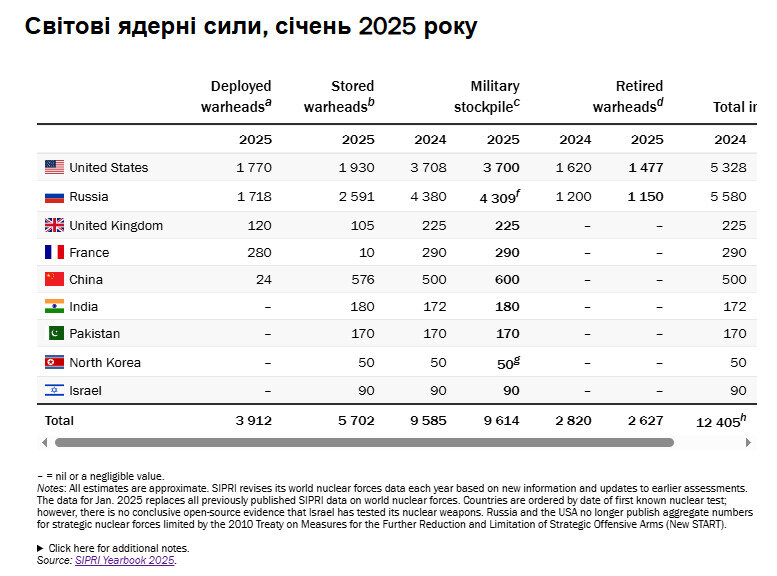China is building up its nuclear arsenal fast, while US and Russia are facing problems - SIPRI. INFOGRAPHICS
In 2024, almost all nine nuclear-weapon states continued their active modernization programs. Thus, China has become a leader in building up its nuclear arsenal, while the nuclear programs of Russia and the United States have experienced problems.
This is stated in the report of the Stockholm International Peace Research Institute (SIPRI), Censor.NET reports.
Almost all 9 nuclear powers - the United States, Russia, China, the United Kingdom, France, Pakistan, India, the DPRK and Israel - continued to update their existing weapons and add new versions last year.
As of January 2025, out of a total global arsenal of 12,241 warheads, 9,614 of them were in military stockpiles for potential use.
"3,912 of these warheads were deployed with missiles and aircraft, and the rest were in a central storage facility. About 2,100 deployed warheads were in a state of high operational readiness on ballistic missiles. Almost all of these warheads belonged to Russia or the United States," the report says.
Although SIPRI suggests that China also places some warheads on missiles even in peacetime.
Pace of development of programs among nuclear countries
It is noted that the United States and Russia together possess about 90% of the world's nuclear weapons. Their military stockpiles remained relatively unchanged in 2024, but both Moscow and Washington are implementing modernization programs to increase their arsenals.
The comprehensive U.S. nuclear weapons modernization program is progressing, but in 2024 it faces scheduling and funding challenges that could delay and significantly increase the cost of the new strategic arsenal. In addition, the addition of new non-strategic nuclear weapons to the U.S. arsenal will put an additional burden on the modernization program.
At the same time, Russia's nuclear weapons modernization program has also had problems. Last year, the state failed to test a new Sarmat intercontinental ballistic missile and delayed the upgrade of its systems.
Moscow has also not yet increased the number of non-strategic warheads, which it was supposed to do in 2020.
Instead, China, according to the research institute, is building up its nuclear arsenal the fastest - by about 100 warheads a year since 2023 - than any other country. Beijing currently possesses at least 600 nuclear warheads.
The report says that China could increase its stockpile to 1,500 warheads by 2035, but this would be about a third of the stockpile of Russia and the United States.
North Korea assembled about 50 warheads last year and has enough fissile material to produce another 40.
In addition, according to SIPRI, Israel is also modernizing its nuclear capabilities, although it does not publicly recognize the existence of such weapons. Last year, the state tested a rocket engine that could be linked to nuclear ballistic missiles such as Jericho, and is also likely to upgrade the plutonium production reactor in Dimona.
"The era of reducing the number of nuclear weapons in the world, which lasted since the end of the Cold War, is coming to an end. Instead, we see a clear trend of growing nuclear arsenals, escalating nuclear rhetoric, and the abandonment of arms control agreements," said Hans Christensen, Senior Fellow at SIPRI's Weapons of Mass Destruction Program.

